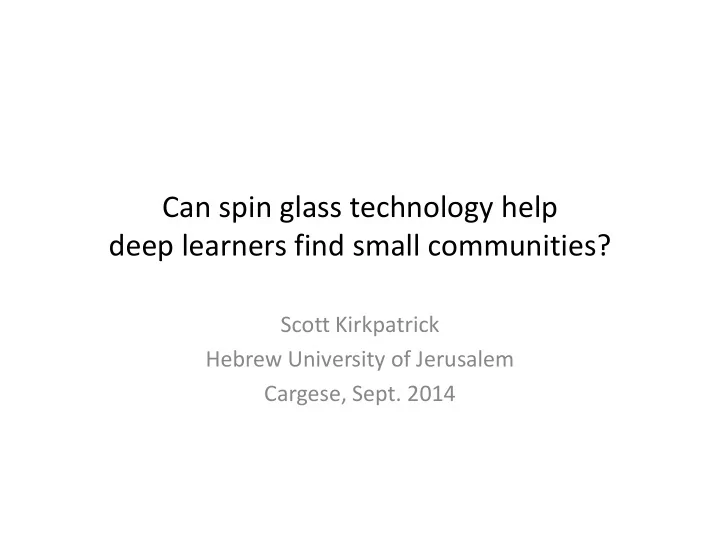

Can spin glass technology help deep learners find small communities? Scott Kirkpatrick Hebrew University of Jerusalem Cargese, Sept. 2014
Communities exist on all scales • Consider Europe, North America -- 300M people, divides into: – Those who might vote liberal, or conservative – Who might buy a model of car – Who might be vulnerable to a common disease… all ∝ 𝑂 • But suppose you are looking for – People who lease private jets? 15-30,000 people in this market – People vulnerable to a rare but genetically linked disease? – These groups may be ∝ √𝑂 but probably still unique. Finally, consider things on the scale of 𝑚𝑝 2 𝑂 • – 30 people. – Generally we search from bottom up, and must focus attention on one cluster which is not unique. – E.g. Terrorist sleeper cells -- you find one bad guy and look for his really close friends. – Can message-passing accelerate this search?
Replicas and Cavity Approach? • These separate small differences in large complex systems. Separate 𝑂 signal from 𝑂 noise. Do they also single out small things? • But still this approach not widely known…
The model of interest – maximal cliques • In an E-R graph ensemble, G(N,1/2) how large is the largest clique? • One of the earliest “sharp” phenomena in combinatorics. – Matula 1970-76 showed that it tends sharply to the integers closest to • R(N) = 1 + 2 log N = 2 log log N + 2 log (e/2) . – But this is just probabilities; how do you find it? • Following old joke about mathematician and lamppost, much effort has shown that there are good ways to find planted cliques of order – c 𝑂𝑚𝑝𝑂 Kucera (1995) – or 𝑑 𝑂 where C > 10 Alon, Krivelovich, Sudakov and many others • (note that any smaller fixed c can be managed, but things tend to get exponentially polynomial) – Can we adapt the tools used to search for even smaller naturally occurring cliques? – Deshpande and Montanari (2013) replace spectral approach with power method, acceleration tricks…
Phase diagram separating problems
Naturally occurring cliques are hard to find • Lower bounds are weak • Ramsey R(k,k) is proportional to log N, not 2 log N – R(k,k) ≤ 2𝑙−2 𝑙−1 • Greedy random search gives also log N, not 2 log N • Simulated annealing has been “proven” to fail – Mark Jerrum, 1992 – Naturally, this got my attention… but it is a more limited claim.
The limits
Are cliques rare? Hardly! Clique size k
Material from the comments • I’ll put equations on the board for #cliques and for # cliques that cannot be extended further. Note many solutions are to be expected. And they seem to be distinct because k #(maximum cliques) = # (cliques of size k-1 that can be extended to size k). This implies the largest possible k-cliques are disjoint, making them possible to hit, since there are many…
Improved search methods • Smarter greedy – at each step select the site with max degree. • Incorporate power method, at each stage in the restricted domain. • De-anchor the search at intermediate or final stages and use power method on existing “friends” and their “family” (work in progress).
For natural max-clique, there are improvements, but problem is still not solved
Where were mistakes made?
A few lessons… • Communities of interest can be local; modularity and dendrograms obscure this. Privacy and security studies also require high density or clique subgraphs. • Power method and message-passing implement spectral imperatives in global scale networks – e.g. Page Rank. They offer soft tools for scaling search down. • Iteration, or stochastic search always helps.
Recommend
More recommend